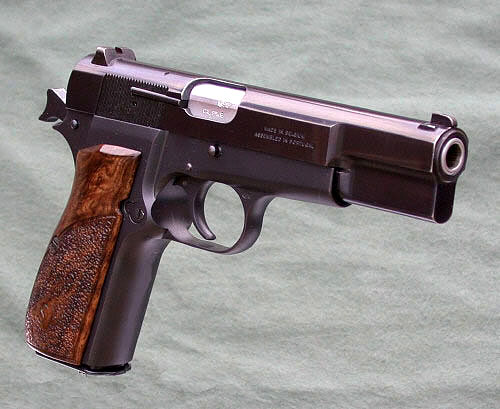
9mm Hi Power Ammo Selection, 2006
For decades the 3+ decades I've been enthralled with the 9mm Hi Power it seems that I've been equally interested in what ammo to feed it when wanting "high performance" on the receiving end, be the receiver animal or human. For about 10 years, this bordered on obsession. I just had to know what the absolute, unequivocal, ultimate 9mm load was.

For years I sought the "ultimate" 9mm load for the Hi Power. I wonder if it really exists? That said, I believe that I've found several that work very well from this platform.
I tried everything a layman with a limited income could: water testing, ductseal, clay, soaked newsprint, gelatin (not 10% ballistic gelatin), meat scraps from a local grocery's butcher as well as shooting more than a few varmints. (I did quite a bit of varmint calling in those days.)
When I became a police officer, I tried to get information on any and all shootings (regardless of caliber) in my area, whether done by my agency or others and wound up with several autopsy reports. In later years I was able to visit with officers involved in shootings, some with 9mm pistols.
What I learned (finally) was that no handgun round commonly associated with anti-personnel use can be counted upon to absolutely, completely, and without fail, deck a determined human adversary 100% of the time, not unless the right portion of the brain is destroyed or the spinal cord severely damaged.
Today there is quite a lot on the topic. Some seems to be "pro-9mm" while other work is definitely "anti." We have the scientific researchers for whom repeatable tests in calibrated 10% ballistic gelatin are documented and reported. Others took a look at a round's "history" of working or not working. Sadly, it appears now that there's been a great deal of polarization between "stopping power" factions. I wish such were not the case and believe that each side has something to offer that might benefit us all.
Though I have quite a few reports out on this site concerning observations of different 9mm rounds, I felt it might be good to do a more current update on ammunition selection. This will also focus on concerns expressed to me from various folks who happen to favor the Browning 9mm Hi Power. Some of these simply want to know the "best" 9mm defense load. Others want the "best" that they can buy in bulk, naturally for the least amount of money. Some are concerned with muzzle flash while others focus on too much or too little penetration.
I do not claim to have the definitive answers, but will present what I believe to be viable choices for Hi Power 9mm ammunition.
Expanding 9mm Ammunition: Then vs. Now
Much has changed since the late '60's and early '70's when I began searching and "testing" the relatively meager selection of 9mm expanding ammunition. Back then there was little discussion about underpenetration compared to whether or not an expanding bullet actually would! Most would when fired into ductseal or clay, but in animals or men, results were often disappointing. I could not make a certain major ammo maker's 115-gr. JHP expand to save my soul though the same maker today offers a number of 9mm JHP's that do reliably expand. The trend was to high velocity and to accomplish this, light-for-caliber JHP bullets were sometimes used. Super-Vel took this approach with their 90-gr. JHP. Eventually, Winchester offered their 115-gr. Silvertip hollow point. The bullet went through several quiet changes along the way, but it usually expanded nicely and was popular in the law enforcement community in several calibers besides 9mm.
After the Miami FBI Shootout in the mid-80's, the 115-gr. 9mm Silvertip fell out of favor when the FBI set forth protocols in which bullets penetrating less than 12" of ballistic gelatin were deemed unsuitable for their use. In most testing, the STHP usually does about 10 to 11". Hornady answered the call with their XTP line of JHP ammo. These bullets were designed to have limited expansion, but deeper penetration that met or exceeded the FBI's recommendations.
Caliber changes from 9mm to the new .40 S&W and others followed just as they had from the 38/357 to 9mm high-capacity autoloaders a few years earlier. The 9mm was once again relegated to "weak sister" status by some.
Today, things are much nicer for 9mm shooters. Companies actually offer expanding ammunition that usually does and bullets weigh in from 90-gr. or less to 147-gr. or more from a few makers. I believe that good defense loads can be had in both standard and +P loadings, but still think that the best are probably in the +P range. We can buy either "old technology" bargain conventional JHP's or the latest flagship loads from practically all of the major ammunition manufacturers. The traditional JHP and Silvertip are still around as examples of "old technology" while Hornady XTP, Federal HydraShok, Winchester Black Talon and others, followed after raising the performance bar, up to the newer Gold Dots, Golden Sabers, Ranger SXT's, and Federal HST lines.
It appears to me that the 115-gr. bullet weight has fallen from favor amongst 9mm fanciers, including Hi Power shooters. It's been replaced with either 124 or 147-gr. expanding ammunition, no doubt at least in part due to the Miami fiasco.

Today's 9mm Hi Power shooter has a wide selection of ammunition to choose from. Here is a small sample of different loads in different price ranges, which represent both old and new approaches to 9mm-bullet expansion. From left to right: Federal 115-gr. JHP, Corbon 115-gr. DPX +P, Hornady 124-gr. TAP (XTP), Winchester 127-gr. +P+, Remington 147-gr. Golden Saber, and Speer 147-gr. Gold Dot. This is but a "drop in the bucket" of available 9mm factory ammunition.
Though I cannot claim to have tried each and every single 9mm load available, I have shot more than a few long-term in repeated informal layman "testing" and seen how they perform on small varmints like fox and 'coons to coyotes and whitetail deer. I have also spoken with a number of people who have been forced to use the 9mm round against humans. If this seems "anecdotal" or without proper documentation/accreditation, it is and to those bothered by it, you have my blessing to read no further. Bye!
I have never claimed "expert" status at anything and the majority of folks who shot people with their 9mm pistols didn't want anything said that could identify them, their agency, or location. I cannot claim expertise as a terminal ballistician, but I can and will keep my word to these folks. For those still reading, let's take a look at some ammunition and how it relates to the Hi Power pistol.
Traditional 9mm JHP Ammunition: The three brands of standard pressure ammunition I'm most often asked about are Federal 115-gr. JHP, Winchester USA 115-gr. JHP, and the same company's 147-gr. JHP.
I have discussed the Federal 115-gr. JHP in a separate article located here:
http://www.hipowersandhandguns.com/HiPowerFederal115.htmAs far as I can tell, Winchester USA 115-gr. JHP uses the same bullet as their Silvertip, but without the electroless-nickel finish that gives it a silver appearance. In most instances, this ammo has proven quite consistent over the chronograph, but in some lots it has had wider extreme velocity spreads than any of the Federal 115-gr. JHP or Winchester Silvertip ammo I've chronographed. It has expanded repeatedly for me in both water and super-saturated newsprint, but I have not shot anything with it, nor have I spoken with anyone using it against a felon. In the past I have seen the STHP used from a Browning against a couple of coyotes, both receiving broadside hits either directly behind or through the shoulders. One dropped, kicked a few seconds and then died. The other ran about 20 yards before doing the same thing. I would expect similar performance from the USA version of the cartridge.
The Silvertip and USA as well as the Federal 115-gr. JHP seem to penetrate roughly 10 to 11" in 10% ballistic gelatin. This is below the FBI 12" minimum and none of these expand as much after passing through various barriers as they do when striking bare gelatin. In some tests, they do penetrate an inch or so more, probably due to a diminished "parachute effect" from less expansion.
All of these have grouped quite well for me out of the Hi Power and have fed reliably.
Were I personally going to choose one for accumulating in bulk, the decision would be between either the 115-gr. Federal JHP or Winchester USA in the same weight. These can usually be found at relatively inexpensive prices in 50-round boxes. I have not seen the 147-gr. Winchester STHP or USA version used on animals, but the few reports I have from people who have actually used it (STHP version) against deadly opponents have not been all that encouraging.
Cutting to the chase, of these rounds, my preference remains the old Federal 115-gr. JHP. (This round used to have product code "BP" but that's been changed to "CBP" with the "C" apparently referring to their "Classic" line of ammunition.) I picked it because while its performance is quite similar to the USA brand, it has a more rounded ogive, which is usually a plus for feeding reliability. This cartridge has garnered a reputation for accuracy. It has not always proven to be the most accurate round in my guns, but it is consistently one of the top.
I have seen this round used on a coyote and it did the trick nicely with a broadside hit just behind the shoulder.
Despite protestations against it by some researchers, it would not bother me to use the Federal 115-gr. JHP for self-protection with the Hi Power, especially if my Hi Power had the classic "humped" feed ramp.
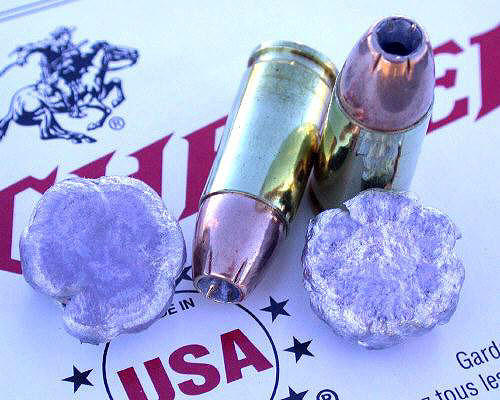
These 115-gr. Winchester USA JHP's were fired into water from a Hi Power. Expanded diameters were roughly 0.64 x 0.61".
That said, were I most interested in hoarding a large supply of expanding ammunition and the USA was significantly less costly than the Federal, I might very well go with it since I know that it's proven reliable in my Hi Power pistols.
Neither use flash retardant powder but I've shot both in dim light and at night where the only lighting was either a headlight or flashlight and I was in no way blinded or had my vision diminished from either load.
Given equivalent prices, I'd go with the Federal 115-gr. first and the USA
second for stockpiling large amounts of Hi Power ammunition.
On the other end of the cost spectrum is Corbon 115-gr. DPX +P. At this time, I think that this is probably the best 115-gr. expanding bullet for the Hi Power. Besides its consistency in penetration and expansion, even through barriers, it has a feed-reliable profile and has proven very accurate for me in a number of 9mm pistols including the Hi Power. Its solid copper bullet design does seem very worthwhile, though it isn't inexpensive! Its solid copper bullet does penetrate deeper than other expanding bullets in this weight.
A detailed report on it is here:
http://www.hipowersandhandguns.com/Corbon%209mm%20115.htm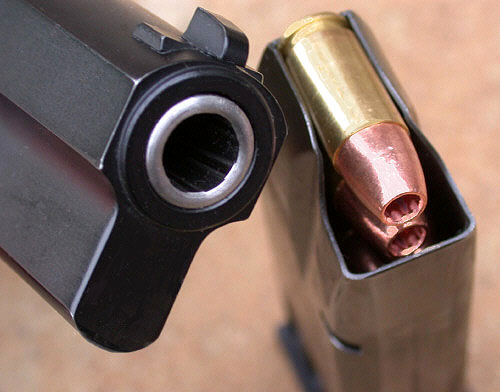
Of the 115-gr. 9mm loads now available, my first choice would be the Corbon 115-gr. DPX. It is a +P load, but one that I believe the Hi Power is capable of handling well.
Getting into the 9mm +P arena is not without possible concerns and the one I recall being asked most often is whether or not +P will ruin a Hi Power. Let's talk about that.
It is simply a fact of life that the hotter the ammunition, the more wear-and-tear on the gun. Though some pistols have a reputation for digesting untold amounts of extremely powerful ammunition, its use will enhance and earlier end of the pistol than less energetic rounds.
The Browning Hi Power has been reported to be "fragile" and some custom Hi Power 'smiths strongly protest the use of any +P ammunition in this classic design. I fully agree that the 9mm Hi Power is probably not as well suited to an extreme diet of +P loads as some other handguns, but I do believe that it can handle larger numbers of some +P ammo than we might be led to believe.
Here is why I believe this to be so. For many years I used very little factory ammunition but shot a 115-gr. Sierra loaded to roughly 1270 ft/sec by the bushel basketful. Quite a bit of this was done using the standard power (17-lb) recoil spring and in guns having the older and softer forged frames. When they became available (or when I became aware of them), I went to the Wolff 18.5-lb conventional recoil spring and have never had a problem; no broken parts, cracked slides or frames, nothing! In more recent years I began using the Buffer Technology shock buff as well.
Another pet load fed to my Hi Powers by the thousands consisted of a Hornady 124-gr. XTP loaded to about 1250 ft/sec. Most of these were shot after I went to the slightly heavier Wolff recoil spring, but not one of my Hi Powers has suffered any failures, small or catastrophic. I can only estimate, but my guns have shot these two rounds literally by the tens of thousands with no problems so I infer that this is probably not too hot for the design, especially the newer Mk III pistols with their harder cast frames and slightly redesigned ejection ports.
"Have you ever seen a Hi Power that had a cracked slide or frame?" is a question I've been asked quite a bit. The answer is yes. I have also seen one with a broken cam and a few with extremely rounded off locking lugs. Some had been fired with quite a bit of +P ammo and others used only standard pressure factory rounds, but each of these guns had one thing in common: very weak recoil springs. In one instance the recoil spring was so weak that I could ease the slide against a partially loaded magazine of ball and it would not strip the round from the magazine when released! It is my belief that while we may get by with weak recoil springs in some 9mm pistols, the Hi Power is not one of them. I suggest (strongly) that if you opt to use +P ammunition in your Hi Power that you go with no less than the factory 17-lb spring. My guns will remain sprung with the Wolff conventional 18.5-lb spring, but I'd replace either after 2K shots of +P.
For those interested in this aspect of Hi Power use, here are some related articles:
http://www.hipowersandhandguns.com/BHPandHighPressureAmmo.htm http://www.hipowersandhandguns.com/Hi%20Power%20Longevity.htm http://www.hipowersandhandguns.com/Buffer.htmAfter quite a bit of shooting and after much consideration I have come to the conclusion that the 115 and 125-gr. JHP +P from Corbon are probably a bit much for the Hi Power's design as a regular diet. In my observation these are truly maximum effort loads. Their 115-gr. JHP is rated at 1350 ft/sec with the 125-grain's velocity 100 ft/sec less. In my Hi Powers, the actual measured velocities are usually over 1400 ft/sec for the lighter bullet and 1300 ft/sec + for the heavier one! I think that these are just a bit "too much of a good thing" for the Hi Power in copious amounts. I would definitely use the 18.5-lb spring and the buffer if shooting very many of either. It is clear that 115 grains @ 1400+ ft/sec is going to result in faster unlocking of the barrel and slide and a higher rearward slide velocity than 115 grains at 1270 ft/sec. I am not so concerned with +P ammunition having higher than standard pressures. I think that the increased rearward slide velocity with either of these loads is just too much for the standard recoil spring and probably right on the line for the 18.5 pound one.
Despite my concerns when using these in the Hi Power and the condemnation from folks wanting no less than 12" penetration in gelatin, these loads appear to work well against human beings! Though my anecdotal information concerns itself only with the 115-gr. version, my own informal tests show that both rounds expand and penetrate about the same in water or super-saturated newsprint.
The 115-gr. Corbon JHP +P uses the aggressively expanding Sierra Power Jacket Hollow Point. It penetrates about 10" of ballistic gelatin. It normally expands aggressively and fragmentation does frequently occur. It expands after passing through 4 layers of denim and smacking ballistic gelatin and it has worked nicely on various animals I've seen shot with it. The folks I've visited with who used it against people reported that it "worked" quite well, but none of these involved shooting through an intermediate object before striking the upper torso. One man reported that in one instance, he got a second chest shot on one opponent, but noted that the bad guy was already falling when he popped him the second time. (His pistol in this incident was a Glock 19, not a Hi Power.)
I have not seen any conventional 9mm JHP do any more damage in animal tissue than this one and believe that it is probably a very effective face-on-no-obstruction factory load, but I also think it's pushing the envelope for the Hi Power.
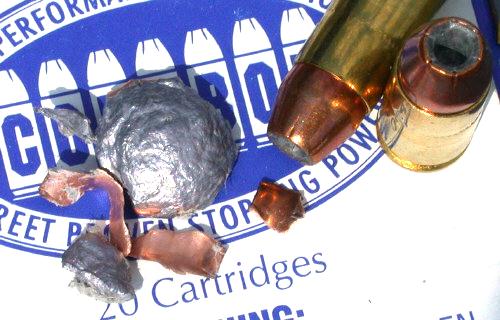
The Corbon 115 and 125-gr. +P loads are visually identical. Note the blunt bullet ogive. This can be a problem in Hi Powers having the older humped feed ramp. I have had no problems with it in Mk II and Mk III pistols, which have the straight-line ramp. Both of these normally group well from the Hi Power. In smaller animals I've seen shot with them, results are graphic and the hits, "dramatic." I have cleanly killed three Texas whitetail deer with one shot each using a handload that was not as hot as the Corbon factory loads. Each was a broadside shot made under ideal conditions with no obstructions. The bullets did exhibit some fragmentation. None exited the deer.
I think that were I going with a conventional bullet 115-gr. +P load, it would be the Remington 115-gr. JHP +P. This bullet has been altered in recent years and has a more feed-friendly ogive. (It is slightly blunter than the older version but continues to feed fine from what I've seen.) I have found it accurate from the Hi Power and it is loaded to about the advertised 1250 ft/sec. In my own informal tests, it fragments a bit less than the Corbon. Opinions differ as to whether or not this is good or bad.
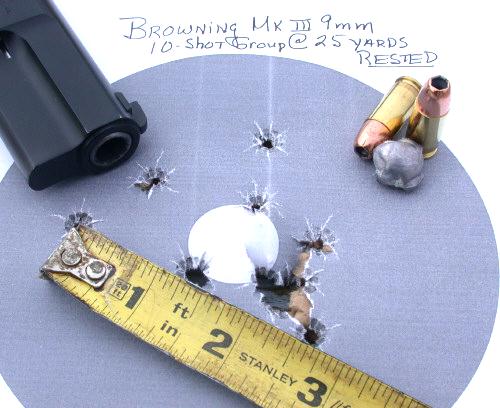
The Remington 115-gr. JHP +P is sold under their "Express" line of ammo. The hollow point is of larger diameter than the older version. The jacket is more obviously skived as well. Its product designation is R9MM6.
In the popular 124-gr. weight and standard pressure, my first choices would be Speer 124-gr. Gold Dot or Remington's Golden Saber. Either of these hit around 1120 ft/sec from the Hi Power. Both normally exceed the 12" FBI protocol and I've found both to be reliable feeders in Hi Powers. The Golden Saber can occasionally shed its jacket in test media or tissue but it's been my observation that if this even occurs, it is usually toward the end of the bullet's path. The Gold Dot jacket is chemically bonded to the lead core and separation is not at all common at these velocities.
Both are available in +P as well. Add about 50 ft/sec to the Golden Saber and 70 ft/sec to the Gold Dot if you go to these versions. I am not sure how much is actually gained in the real world. It is my understanding that NYPD is using the 124-gr. Gold Dot +P with no complaints relative to "stopping power." I am aware of one shooting with the standard pressure Golden Saber and one with the Gold Dot. Each man achieved the elusive "one-shot stop". (One was using a Hi Power and one a Beretta 92.) I believe that the Golden Saber uses flash retardant powder, but I am not sure on the Speer.
I have no particular preference between these two and would go with whichever proved reliable. If both did I'd make the decision based on which grouped best for me. It may be true that shoot-don't-shoot civilian shootings occur at close range, but I still prefer to have an accurate gun/ammunition combination just in case I'm unlucky enough to be the rare exception to the rule. If concerns over possible bullet/jacket separation are important to you, I'd try the Speer and if it proved satisfactory, I'd never look back.
It is my belief that neither of these two loads in the +P version is too hot for steady use in the Hi Power. I would still go with the 18.5-lb spring, however.
I have not mentioned Hornady's TAP standard pressure 124-gr. ammunition. The reason is that I want to shoot more of it as loaded by the factory. That said, I really like the XTP bullet when fired at a handloaded 1250 ft/sec. The factory load, which yields about 100 ft/sec less, has proven extremely accurate and reliable in feeding. It seems to garner little respect from most members of the "stopping power" community. Its bullet is designed to expand about 1.5x caliber and exceeds the FBI penetration protocol. At factory velocities, its expansion can be retarded by the dreaded 4 layers of denim. I have had excellent results with the XTP bullet in several handgun calibers including 9mm against animals and the XTP seems most popular with handgun hunters. I have no personal reports on the factory 9mm TAP used against felons and have read only a couple of incidents in which it is said to have performed fine, but I am unaware of the actual circumstances in either. I think that it is probably a viable defense load and wouldn't complain if using it in my Hi Power. In standard pressure, it is going to be one of the deeper penetrating rounds. The factory TAP ammunition I tried in my Hi Powers was some of the earlier vintage. I want to try some of the newer version before venturing a guess on this ammo. It is possible that some tweaking has taken place.
Though at the upper edge of what I believe viable for long-term use in the more heavily sprung Hi Power, I've been very impressed with Winchester's 127-gr. +P+ Ranger load designated by them as RA9TA. It has been consistent over the chronograph, accurate, and expands reliably while exceeding 12" penetration in ballistic gelatin.
For those interested, here is a link to a more detailed report on it:
http://www.hipowersandhandguns.com/HiPower127Winchester.htm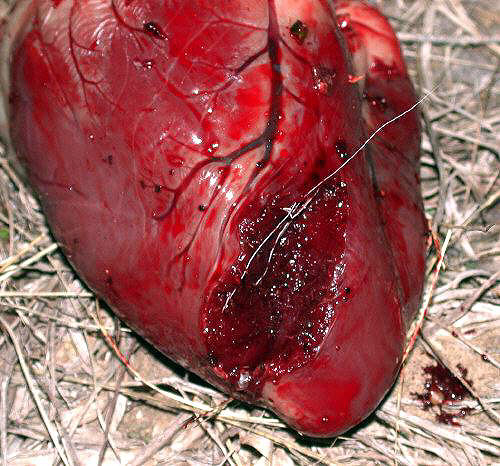
This deer's heart was grazed by a 127-gr. Winchester +P+. A small Texas whitetail, it was immediately "stopped" with one shot.
More and more 9mm users are going with the 147-gr. expanding ammunition for serious purposes. Recent tests have convinced me that the following are probably the best examples of this 9mm bullet weight. They can be expected to both expand reliably and exceed the 12" penetration "rule" favored by many these days. They are:
Remington 147-gr. Golden Saber
Winchester 147-g. Ranger
Speer 147-gr. Gold Dot
I did a pretty extensive report on these here:
http://www.hipowersandhandguns.com/BHP%20and%20147%20gr%20Ammo.htmSince I wrote this I have shot quite a bit more of this ammunition and want to change one thing. It really doesn't much matter to me which of these three I'd use in a Hi Power. All proved accurate and reliable and worked fine with either the factory spring or the 18.5-lb Wolff.
Changes in Opinion: As a result of more shooting, I have rethought some aspects of Hi Power 9mm ammunition.
1. I am not adamantly opposed to the use of 147-gr. ammunition if it is one of the three loads mentioned previously. There may be other offerings in this weight that work well, but I feel confident with these. The Speer and the Remington both exceed 1000 ft/sec from the Hi Power but the Winchester is not far behind.
The three loads mentioned do seem to be working well in gunfights from what I've read. I have not spoken with anyone who has used these.
2. In the 124-gr. weight, the standard-pressure Speer Gold Dot and Remington Golden Saber are probably at the top of the list for self-protection. I am not sure that much if anything is given up to their +P counterparts but am convinced that the Hi Power can handle either version nicely. I am not sure if there is much difference between a 124-gr. Gold Dot @ 1100 ft/sec + and its 147-gr. counterpart moving but 100 ft/sec less. It probably doesn't matter between these standard pressure loads.
3. I have come to prefer the Corbon 115-gr. DPX +P to Winchester's 127-gr. +P+ in the Hi Power. Both have proven to expand consistently under varied conditions and both penetrate beyond 12" in ballistic gelatin. Both have been reliable in my guns and are accurate. Even though the DPX has not been proven "on the street", as has the 127-gr. Winchester, reports from serious testers as well as my own observations strongly suggest that it should be a very good defense load. I think it is probably enough "easier" on the Hi Power than the +P+ to warrant the change while still offering enough velocity to satisfy my higher velocity preference to 9mm "stopping power."
Conclusion: Today's 9mm Hi Power shooters are blessed with many good choices in 9mm ammunition. Though the best loads probably are with the newer technology bullets, that does not necessarily mean that anything older is useless. Federal's old 115-gr. JHP doesn't garner much praise from some serious researchers while others present opposing opinions. When its successful use is reported, it seems that it's said that the incident in question is not "statistically valid" or something to the effect of "anything will stop an aggressor some of the time." Yet, the Miami FBI shootout is a single incident and has been used to decry 9mm rounds penetrating less than 12". In other shootings both the often-maligned Winchester 115-gr. STHP and Federal 115-gr. JHP have done the trick. I am personally aware of a couple of such incidents and have "anecdotal" reports from others in which the same satisfactory results were achieved.
Even so, I believe that the Miami thing also resulted in more R&D with the 9mm cartridge and ammunition that is likely more potent over a greater number of scenarios. For straight-on, unobstructed shots, I believe that any of the loads mentioned here would do the trick, assuming proper placement. If one envisions having to shoot an aggressor from the side or through a windshield, etc, the newer loads probably do offer a better chance at being effective. If I remember correctly, roughly 30% of police shootings involve a backup officer firing from the side of the offender. I would expect this to be significantly less in defense shootings by private citizens. We are not very likely to be backing up anyone but facing one or more miscreants head-on.
Though I still believe that the most potent 9mm defensive loads bear a +P or +P+ designation, I am no longer convinced that the difference is necessarily dramatic between it and a more sedate standard pressure load. This is for a couple of reasons. One, as previously mentioned, private citizens are most likely to be in face-to-face confrontations. Two, standard pressure 9mm ammunition usually achieves enough velocity to work fine when fired from the Hi Power. This seems true with both the old and new technology loads mentioned in this article.
For now, I continue to cast my lot with the faster 9mm ammunition but also believe that the mentioned standard pressure 124 and 147-gr. ammunition is good stuff and capable of ending a felonious deadly attack.
In short, I am suggesting that any of the loads suggested for use with the Hi Power are capable of doing what we want. Pick the one that works best for you. If shooting any +P in your Hi Power bothers you, go with any of the standard pressure 124 or 147-gr. loads suggested. If you want +P but still have concerns over wear-and-tear, my current first choice is Corbon 115-gr. DPX +P. Some will continue to use the super fast 115-gr. Corbon JHP +P. No arguments here, but I do suggest going with the heavier spring setup with this chili pepper load for sure.
I think we might get a little too wrapped around the axle over defense ammunition for our Hi Powers. Perhaps we should be more concerned with being able to accurately deliver a shot or shots in compressed time frames. The elusive "one-shot stop" is probably just not in the cards for any handgun round normally associated with self-defense if facing an enraged or doped up felonious aggressor; I am sure that it is not with poor hits.
For me, my choices of defense ammunition for the Hi Power would be ranked as follows:
I do not believe that the 9mm Hi Power is a "weak" handgun/caliber combination but neither do I think it is a death ray with any ammunition. More important is the user's willingness to use it combined with proper tactics and competence in getting the required hit or hits. One of the attributes of the Hi Power is that many find it easier to shoot accurately and quickly than other 9mm pistols. I have found them reliable in the extreme and easier to shoot one-handed at speed than any other 9mm handgun. With decent ammo, mindset and skill, I believe the Hi Power remains a top choice in 9mm pistols.
Of the ammunition above, I've presented my choices. You make yours based on the factors most important to you and then make sure that your skill level is up to the task. I am not suggesting that ammunition selection is moot; I do think it is secondary to our own abilities. "High performance" doesn't just refer to ammunition selection in my opinion.
Best.